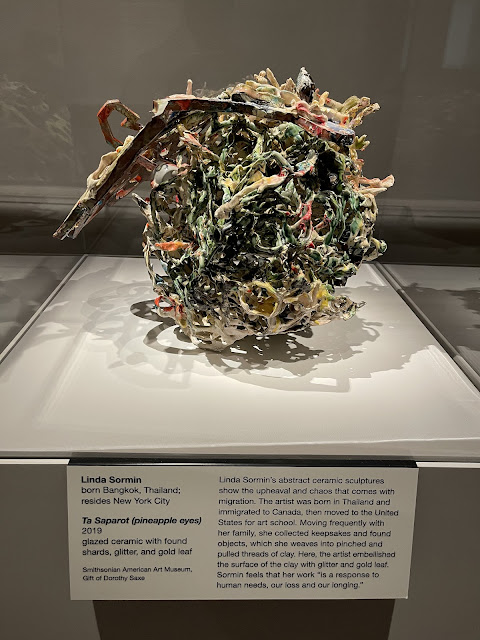“I found I could say things with color and shapes that I couldn't say any other way - things I had no words for.”
—Georgia O'Keeffe
By Alex P. Vidal
THE best reason to visit Washington D.C. nowadays is the Renwick Gallery of the Smithsonian American Art Museum, which is celebrating its 50th anniversary.
If we go to Washington D.C. and miss the other museums, we must see to it that we prioritize the Renwick Gallery, which runs This Present Moment: Crafting A Better World from May 13, 2022 until April 2, 2023
Located steps from the White House in the heart of historic federal Washington, this National Historic Landmark was designed by architect James Renwick Jr. in 1858 and was the first building in the United States built specifically to be an art museum.
I visited the Renwick Gallery after the Smithsonian American Art Museum on 8th and G Streets, NW.
Entrance in both museums are free.
This Present Moment: Crafting a Better World showcases the dynamic landscape of American craft today.
The exhibition highlights the role that artists play in our world to spark essential conversations, stories of resilience, and methods of activism—showing us a more relational and empathetic world.
It centers more expansive definitions and acknowledgments of often-overlooked histories and contributions of women, people of color, and other marginalized communities.
-o0o-
One of the four arts in the exhibit that caught my eyes in the Renwick Gallery was Ta Saparot (pineapple eyes) by Linda Sormin, a Bangkok-born New York resident.
Ta Saparot is made of glazed ceramic with found shards, glitter, and gold leaf.
The abstract ceramic sculptures show the upheaval and chaos that comes with migration.
Moving frequently with her family, the artist collected keepsake and found objects, which she weaves into pinched and pulled threads of clay.
Here, the artist embellished the surface of the clay with glitter and gold leaf.
According to the art description, Sormin feels that her work “is a response to human needs, our loss and our longing.”
-o0o-
The other was Santa Chingada: The Perfect Little Woman by Kukuli Velarde, born in Lima, Peru and based in Philadelphia, Pennsylvania. It is made in ceramic and mixed media.
According to the art’s description, Kukuli Velarde portrays her inherited memories and emotions. Her series of squatting ceramic figures, called Isichapuitu, were inspired by a Peruvian myth about a priest who used vessels called Manchaypuitu(male) and Isichapuitu (female) to summon spirits from the past.
This Isichapuitu embodies a “Perfect Little Woman,” after the Virgin Mary of Sorrows, a mournful figure with seven daggers piercing her heart.
This woman has no power over her own body: she is pregnant but wears a chastity belt, and she wears a mask of an idealized white woman.
Velarde crafts a charged moment, as if the woman has woken up and realized her confinement. She removes the mask to show herself as a fierce Indigenous woman.
Velarde wrote the text around the sculpture’s edge: I open my arms to you, saying “I am yours.” Nail your thorns on me. I will be the one who heals your wounds and relieves you from your sorrows. I do not ask for anything in return. If something, maybe a little of your love … If something, maybe just to know I am your savior, the sacrificed mother of your children … Any offense you inflict on me is welcome as my token … For your veneration …
-o0o-
The third one that caught my attention was Araña by Cristina Cordova, born in Boston, Massachusetts. It is made of hand-built ceramic with glaze and stain.
According to the art’s description, Cristina Cordova shapes earthly matter into mythic figures.
This uncanny Araña (Spanish for spider), with its androgynous human torso on seven spindly legs, startles all sense of reality.
The artist, who currently lives in the Blue Ridge Mountains of North Carolina, grew up in Puerto Rico, where she was drawn to the prevalent icons of Catholicism—figures that bind together the contradictions of agony and ecstasy, corporeal and magical.
“Here, Cordova has begun a story and invites you to finish it,” read the art description.
Meanwhile, the Smithsonian American Art Museum currently runs We Are Made of Stories: Self-Taught Artists in the Robson Family Collection from July 1, 2022 until March 26, 2023.
We Are Made of Stories: Self-Taught Artists in the Robson Family Collection traces the rise of self-taught artists in the twentieth century and examines how, despite wide-ranging societal, racial, and gender-based obstacles, their creativity and bold self-definition became major forces in American art.
The exhibition features recent gifts to the museum from two generations of collectors, Margaret Z. Robson and Douglas O. Robson.
Also in the Smithsonian American Art Museum I visited in the morning before the Renwick Gallery was Artist to Artist, which features paired artworks, each representing two figures whose trajectories intersected at a creatively crucial moment, whether as student and teacher, professional allies, or friends.
It runs from October 1, 2021 until September 3, 2023.
(The author, who is now based in New York City, used to be the editor of two local dailies in Iloilo.—Ed)




No comments:
Post a Comment